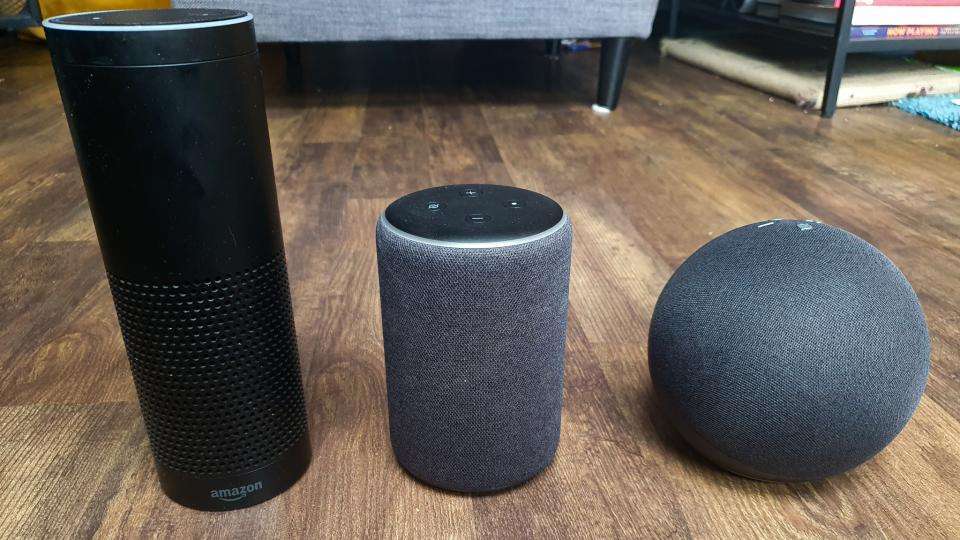A new Amazon Echo is now clearly an annual tradition. If Amazon can push out a new, improved smart speaker even in a year blighted by global pandemic, then it’s pretty clear this product line is going to be updated even more frequently than the Kindle .
And while the fourth-generation Amazon Echo isn’t an essential upgrade for those already in the ecosystem, it is, nonetheless, a very good product in its own right.


Amazon Echo 4th generation (2020): What you need to know
It’s certainly enough of an improvement that people with an Echo or two in their home may consider getting this new version as their main speaker, retiring an earlier version to the easier life of the bedroom or study.

While the most obvious change is the design – it’s now like a miniature bowling ball or a fabric-covered cantaloupe melon – there are improvements on the inside as well. While the previous generation had a 3in woofer and a single 0.8in tweeter, the 2020 Echo keeps the specs the same but adds a second 0.8in tweeter.
While this sounds like a straightforward upgrade, it’s a trade-off: previous Echo devices deliberately stuck to a single tweeter in order to provide 360-degree sound. With two tweeters, the Echo is more directional, but it comes with an important improvement: like the Nest Audio and Apple HomePod , the Echo will now adapt to the room’s acoustics for a better listening experience without the need to tinker. On top of that, this is now essentially an Echo Plus . Last year’s Echo blurred the lines by offering identical form factor and sound quality, but the latest Echo removes the line completely by adding support for Zigbee. What that means in layman’s terms is that the new Echo can be your smart home hub – something that used to cost extra.
Alexa – Amazon’s digital assistant – is once again the star of the show, but you don’t miss anything by not upgrading, given that it lives in the cloud and has the same smarts whatever device you talk to it on.
Amazon Echo 4th generation (2020): Price and competition
Despite these improvements, the fourth-generation Echo still costs £90 , which is an absolute steal. Those with long memories will remember that when the original Echo arrived in 2016, it would set you back £150. Of course, these prices aren’t decided in a vacuum, and it’s no coincidence that the Echo’s chief rival – Google’s Nest Audio – also retails for £90 . Apple’s solution – the HomePod – will still set you back £279 , at which point you’re in Google Home Max and Echo Studio territory. Returning to the sub-£100 price point, the only serious alternatives are smart displays, and the brands will seem all too familiar. The Echo Show 5 and Nest Hub both go for £80 , and offer a vibrant display for videos and pictures, in return for an unmissable dip in sound quality. Given they can all live together on the same network, many people decide it’s not an either/or situation.
Amazon Echo 4th generation (2020): Design
There’s no question about it: this is the most dramatic change in design since Amazon first started making smart speakers. The original Echo was a tall, industrial-looking cylinder with a twistable top for adjusting the volume. This became a shorter, stubbier fabric-covered cylinder for the second and third generations. Now, cylindrical is out and the sphere is in.
In the picture above, it's next to the new Echo Dot, which mimicks the look, and it's a style that’s growing on me, I think. The fabric is still there, although now only covering two-thirds of the device, with a matte plastic on the remaining section. The ring of light that activates when you say the “Alexa” wake word has relocated to the bottom, which I’m a big fan of, purely for the warm glow it casts onto the surface it’s sitting on. I imagine it would look equally fetching if wall-mounted via the screw hole in the bottom. That said, it does feel that Amazon doesn’t really know what to do with the buttons. The plastic Mute, Action, Volume Up and Volume Down keys all sit adrift on the fabric, ruining the minimalism that the design otherwise achieves. I’m not for a second advocating that Amazon gets rid of the buttons – anybody who’s struggled to be heard shouting “Alexa, turn the volume down” over an overly loud track will know that’s asking for trouble – but it does feel like they’ve been stuck on without much thought for the overall look.
Like previous Echo devices, the fourth-generation speaker includes a 3.5mm line in/out jack – something that’s welcome, but increasingly less necessary. There are cheaper ways of adding Alexa to your dumb speaker , and the sound quality is good enough at this point that you don’t really need to outsource audio playback. Still, it’s handy if you want to plug in a phone or MP3 player without faffing about with Bluetooth.
Amazon Echo 4th generation (2020): Performance
So, how does it sound? Excellent, as far as £90 speakers go. While the distance between the two tweeters doesn’t allow for proper stereo separation, it’s still far better than what we’ve heard in past Echo devices, especially if you enjoy tracks that take advantage of multi-channel audio. I placed the third-generation Echo next to the 2020 model, alternating the same tracks between them on Spotify Connect. The newer model sounds noticeably richer and fuller, with a sound that’s altogether less hollow. It’s subtle, but put the two side by side and nobody would pick the older model – itself no slouch in terms of sound quality. This can be improved even further if you fancy pairing it with the £120 Echo Sub .
The sticking point is that to our ears the Nest Audio sounds better overall. It’s fuller at the bottom end, and more balanced overall, leading the fourth-generation Echo sounding a touch reedy by comparison. Both are very good, but if sound quality is everything for you, then you’ll want to back Google this time around. Another reason to back Google is the smarts of the virtual assistant. Alexa has got smarter, but it’s still not up there with Google Assistant, both in terms of understanding what you want, and providing an appropriate answer to your queries. Even Google Assistant’s jokes are better. Still, if you just want a smart speaker to play music and answer basic questions about the weather and your daily schedule, then it’s much of a muchness. And it’s important to remember the new Echo has an ace up its figurative sleeve: Zigbee .
Zigbee, for those unfamiliar, is a wireless communication protocol designed for smart homes. If your smart-home kit – be it a light bulb or a thermostat – supports Zigbee, then you can ditch the hub it comes with, and have it talk directly to your Echo instead. Previously this was a feature you had to pay extra for, in the form of an Echo Plus – now it’s available at the low-low price of £90. Happy days if you have compatible devices – although it’s worth noting if you already own a bunch, then you’ll have to reset them all to get them to pair with Alexa. There’s also a very real risk that you won’t get the full functionality of a compatible device if you don’t use the hub it comes with, so it pays to check before you jump through the setup hoops. Still, this really is looking a gift horse in the mouth: the point is this was once a feature that cost an extra £50, and now it’s included in the £90 price. Thank you Amazon.
Amazon Echo 4th generation (2020): Verdict
With all its first-party hardware, Amazon has a proud history of making small quality-of-life improvements with each generation, and the 2020 Echo is no exception. It sounds better than ever, the new design is stylishly bold, and Zigbee – a formerly premium feature for the Echo Plus – now comes as standard. Getting all of this in for the already competitive £90 price was always going to result in a five-star review.
But if you’re looking to buy your first smart speaker, and aren’t already wedded to the Amazon echosystem (that started as a typo, but I’m claiming it as an intentional pun), then you owe it to yourself to investigate the Nest Audio first. The sound quality is a touch better, and Google Assistant is more likely to wow you with its smart capabilities.
